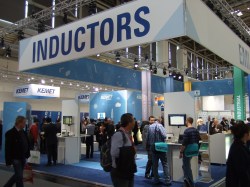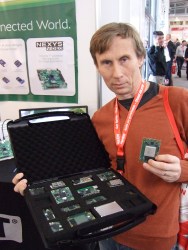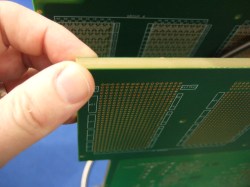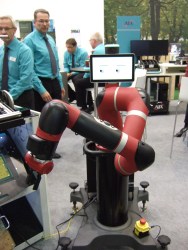The Electronica trade show in Munich is so big that it only takes place once every two years. Every manufacturer, distributor, and maker of anything electronic is there. To get a feel for the scale of things, Electronica is spread out over twelve large exhibition halls and is served by two separate subway stations, one on either end. You wouldn’t think there would be so many inductor manufacturers in the world, but you’d be wrong.
 It’s a hardware geek’s paradise, even if it is aimed more at facilitating industry contacts than at serving the humble hacker. But it’s great to see what is out there, quiz reps of all our favorite chip manufacturers about what they’ve got going on, and just generally wander around. You might not get to play with the multi-gigahertz scopes on a day-to-day basis, but you can get hands-on with them at Electronica. And as cool as it is to talk directly to the representatives of our mega-manufacturers, it’s maybe more fun to check up on the creative fringe of companies that you’ve never heard of before, but who nonetheless have great ideas.
It’s a hardware geek’s paradise, even if it is aimed more at facilitating industry contacts than at serving the humble hacker. But it’s great to see what is out there, quiz reps of all our favorite chip manufacturers about what they’ve got going on, and just generally wander around. You might not get to play with the multi-gigahertz scopes on a day-to-day basis, but you can get hands-on with them at Electronica. And as cool as it is to talk directly to the representatives of our mega-manufacturers, it’s maybe more fun to check up on the creative fringe of companies that you’ve never heard of before, but who nonetheless have great ideas.
Tag Connect
 Tag-Connect is one of those simple ideas that perfectly scratches an itch that we personally have all the time: temporarily hooking up programming or debugging pins to a PCB. It’s basically a cross between a full programming pin-jig and a connector: a few alignment pins pass through holes in the board, and that serves to perfectly align pogo pins with their targets. The trick is that this makes a nearly zero-cost programming header — a few holes and some copper pads — that aligns as easily as a full pin-header or test jig. The coolest connectors of theirs have little grippers that hold them on to the board while it’s on the bench.
Tag-Connect is one of those simple ideas that perfectly scratches an itch that we personally have all the time: temporarily hooking up programming or debugging pins to a PCB. It’s basically a cross between a full programming pin-jig and a connector: a few alignment pins pass through holes in the board, and that serves to perfectly align pogo pins with their targets. The trick is that this makes a nearly zero-cost programming header — a few holes and some copper pads — that aligns as easily as a full pin-header or test jig. The coolest connectors of theirs have little grippers that hold them on to the board while it’s on the bench.
[Neil Sherman] himself was there, and seemed a little surprised that I would tell him straight up that I loved his idea enough that I’ve experimented with ripping it off at home, but was reassured when I mentioned it was on home-made PCBs for personal use. You’ll find his connector footprints everywhere if you start looking: on development boards from TI, Microchip, and others.
BotFactory
 We also ran into some folks from BotFactory. We’ve actually covered their all-in-one PCB machine before, but it was fun to see it in the flesh. It lays down conductive ink and solder paste, and then has a pick-and-place head that can populate the fresh traces and a heated bed that can reflow solder the parts into place. In principle, it’s a complete PCB fabrication machine. And the machine is almost self-replicating: the production PCBs are outsourced, but they use its pick-and-place and soldering functionality in their own manufacturing chain which ends up being cheaper than getting it done out of house. Cool.
We also ran into some folks from BotFactory. We’ve actually covered their all-in-one PCB machine before, but it was fun to see it in the flesh. It lays down conductive ink and solder paste, and then has a pick-and-place head that can populate the fresh traces and a heated bed that can reflow solder the parts into place. In principle, it’s a complete PCB fabrication machine. And the machine is almost self-replicating: the production PCBs are outsourced, but they use its pick-and-place and soldering functionality in their own manufacturing chain which ends up being cheaper than getting it done out of house. Cool.
Antti Lukats
 While looking through the prototyping boards at the Digilent booth, we ran into [Antti Lukats], a Hackaday Prize finalist and all-around good guy to know when it comes to FPGAs. In his black box of tricks was an insane multi-core Zynq board with 14 DC/DC converters and 13 LDOs to support all of its power domains.
While looking through the prototyping boards at the Digilent booth, we ran into [Antti Lukats], a Hackaday Prize finalist and all-around good guy to know when it comes to FPGAs. In his black box of tricks was an insane multi-core Zynq board with 14 DC/DC converters and 13 LDOs to support all of its power domains.
We also chatted about the state of open-source FPGA toolchains, having only Icestorm for the one for the Lattice Ice40 chips. He suggested that we were close to getting an open-source flow for some unspecified Xilinx FPGAs, which would be a huge coup. [Clifford], if you’re out there and want to send us a tip, you have our email address.
40 Layer PCB
 Custom PCB board house Cibel from France got us with their display: a PCB was about a centimeter thick. We walked up to it and pulled out our camera, and their rep answered our question before we could even ask it: 40 layers. They make high-density test boards for the IC manufacturing industry, and they need that many layers to make what is essentially a desktop-sized breakout board.
Custom PCB board house Cibel from France got us with their display: a PCB was about a centimeter thick. We walked up to it and pulled out our camera, and their rep answered our question before we could even ask it: 40 layers. They make high-density test boards for the IC manufacturing industry, and they need that many layers to make what is essentially a desktop-sized breakout board.
Aside from Cibel, there was an entire exhibition hall of PCB manufacturers showing off their wares, competing to have the highest resolution, print on the strangest substrates, and cut out the most intricate outlines. We don’t have to hide our secret shame here on Hackaday: it was beautiful!
Laser Soldering
We had no idea that there were automated laser soldering machines that work by dispensing a glob of solder paste onto a pin and then hitting it with an IR laser hard enough to melt that one joint. But we got to see one in action. This would also be a neat DIY’able device, because it’s basically just a 3D printer chassis with a paste dispenser and a high-wattage IR diode laser strapped on where you’d find the hot end.
It could do about one joint per second, and the main advantage is that it only heats up that one specific joint so that other temperature-sensitive parts on the board are unaffected. The representative said it was used in the automotive sector, but we want one for home. We couldn’t get a good photo, because everything was happening inside an opaque box, which is good practice with high-wattage lasers.
Robotics and Automation
 There was a lot of amazing automation in the testing pavilion, but the surest sign that the robots have taken over was watching the Sawyer robot do its thing. If you followed the Baxter robot’s development, it promised to be a human-compatible, light-industrial robot that could be quickly trained to automate simple repetitive tasks. The Sawyer is a one-armed Baxter, but with an extra degree of freedom in that one arm. It’s a compliant robot — there are springs between the motors and the hard parts of the arms — and you can watch it bobble ever so slightly as it moves.
There was a lot of amazing automation in the testing pavilion, but the surest sign that the robots have taken over was watching the Sawyer robot do its thing. If you followed the Baxter robot’s development, it promised to be a human-compatible, light-industrial robot that could be quickly trained to automate simple repetitive tasks. The Sawyer is a one-armed Baxter, but with an extra degree of freedom in that one arm. It’s a compliant robot — there are springs between the motors and the hard parts of the arms — and you can watch it bobble ever so slightly as it moves.
The point of the springs, and the rest of the robot, is that it can feel when it hits unexpected resistance, like when it bumps you or when you grab its arm. In the latter case, it stops and waits for you to manipulate it around and teach it a new motion. It has cameras, knobs, and more software smarts that make retraining the bot look very easy indeed. We don’t drive a Ferrari, but if we were even tempted to do so, we’d buy three of these robot arms instead.
Random Gallery
We took many photos. Here are the ones that we’re showing in public. If you’re ever in Germany during an even-numbered November, you owe it to yourself to come on down to Electronica. Drop us a line and we’ll hang out!
Banner and thumbnail images courtesy Electronica 2016























I grab one of this “not a Candy”s, delicious.
Iron deficiency?
I’m floored by that sign… you wonder how many people got them to their mouths before the warning was put in place (look somewhat like mint lifesavers).
Last a lot longer though.
Any good swag?
Welcome to the wonderful world of Hammond Manufacturing. If it comes to transformers or die-cast enclosures, they have your back.
I was there two years ago, on the last hour of the last day. They didn’t want to ship all their display units back, so they gave me this thing. They had tons of guitar pedal enclosures and very large, very heavy transformers. I could have built an awesome tube amp with these parts but had to leave them behind because I was still living out of a carry-on for the next week.
Other swag? All the booths had harbo gummi bears – the real ones, made out of horse hooves.
Original HARIBO bears are made from pigs’ skin gelatin. Previous to the mad cow disease outbreak in the UK it was cow (I think – or maybe it was only their competitor KATJES).
Hey Hammond. They 90’s called and want their website back. ;)
I manages to come away with a half dozen nice Hammond enclosures, a Cypress PSOC dev board and an Infineon 24V PROFET shield, plus the usual haul of pens and stationary.
Throw in a few free drinks at various stands when I pretend to be a big shot businessman and it paid for the ticket at any rate.
Forget the Hammond ugly old enclosure and have a look at the Takachi ones: http://www.takachi-enclosure.com/
I came back with the catalogue and a bunch of IP rated hand-held box: they are magnificent!
Brian’s right about the Hammond display / swag pile. I didn’t take any b/c I have to de-clutter my boxes/cases stash as it, but don’t think it was easy.
I picked up a dev kit for the new Atmel/Microchip ATtiny417, and will probably do a writeup. It’s interesting.
Mouser mug. Digikey soccerball. That sort of thing. Honestly, you’re limited by your tolerance to carry stuff home. :)
Any cheap anti-gravity ahead?
I wonder how long it took before that “This is not a candy!” sign became necessary…
Not long, I think. I read the sign, and then looked at the contents and thought “those look delicious!”
I’ve nearly given up on Tag-Connect. The idea and resulting product is great. I sometimes question the high price tag, but it Is still a worthy value to me. My main issue is I have to go out of my way to buy them. They are in-and-out of stock on their own web-site and NA distributors like Digikey, Mouser, Arrow, Newark, etc rarely have stock. I hoped the supply and distribution problems would have worked themselves out over the last few ‘years’ now, but alas no.
Was there, simply amazing: to find oversee manufacturers and suppliers it’s a very good start!
At what moment did Vladimir Putin stop invading Ukraine and start doing FPGA designs instead?
The photo captioned “Jacking into the matrix” is an interesting one. The cyberpunk portion of my brain foresees future conferences when your face-to-face meetings include everyone strapping on the ‘ole VR rig and taking a walk through the factory together.
Heh, bunch of management types, only buzzword familiar with the tech, screwing up like Wonka’s guests…
Looks like a Formula E car not a Formula 1 car.
Yep. The words “All-Electric” on the stand is a bit of a giveaway…
Looking closer, it’s Daniel Abt’s ride (German flag & D Abt on air intake).
Sry. Not a car guy. It would totally make sense, though. Heck the other ones might have been too. I’ll fix that.
My colleague was there. We made a list beforehand, looking at every (test equipment) website and figuring if they had wad we need. Chose about 40 stands to visit, visited 30. It’s impossible to talk with them all, see everything there is to see. It was a day hard work and that was just one of the halls…
I feel like you should be able to do something with a 40 layer board, like a microwave circuit or something…. do as in, do with the board layouts, components made with copper and space (Insulator).
What would really be trick is embedding components into internal pockets as the board is layered together. How’s that for No User Serviceable Parts Inside?
Factual antennas maybe?
40 layer hacker-badge someday?
*Fractal
What stall was that LED yarn on? I’d love to get my hands on some of that stuff
http://www.harvatek.com — absolutely no affiliation, but it was cool enough that I shot their logo.
Anyone else feel that Digikey pissed a shit-ton of budget on absolutely nothing useful – just a ton of footballs & dumb games on their stand ( not to mention the lanyards and napkins…)
If you’re talking about it, it worked.
The dumb games were there two years ago too. I think that they’re fully amortized by now — it’s just the shipping cost.
But Mike, what’s the coolest thing you saw?
I’m surprised nobody commented on what Antti said about the open-source Xilinx toolchain. I *really* want that.
Yup! If it’s Spartan 3, I’ll be delirious. If it’s Spartan 6, I don’t know what will happen…
I didn’t get to quiz him hard enough. But he did mention that the effort is entirely clean-room, and will be licensed such that Xilinx can’t buy it and close it up — as they apparently did with a previous effort.